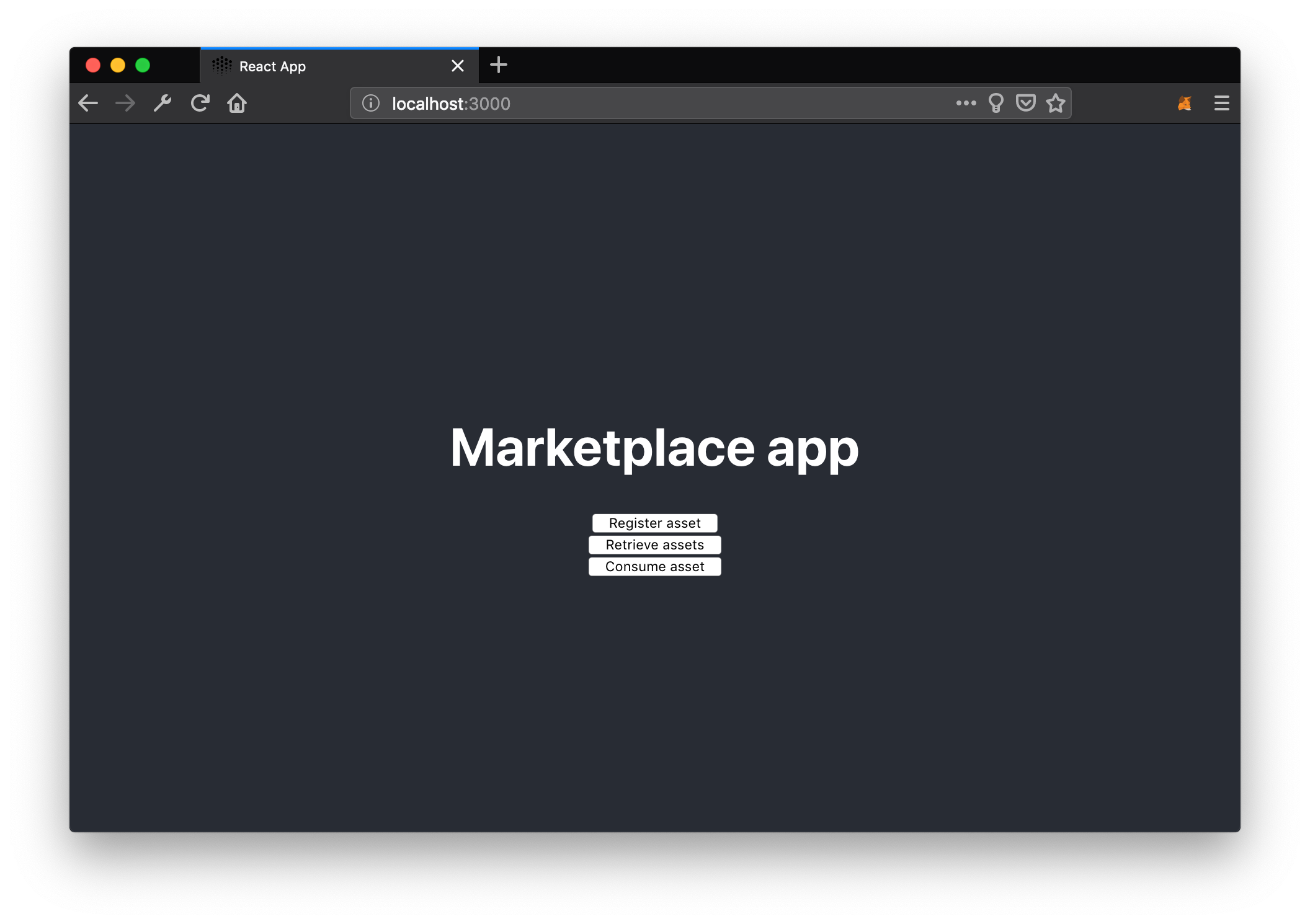6.3 KiB
| title | description |
|---|---|
| Get & Use a Data Set | Tutorial to get and use a data set in a basic React app. |
Requirements
This is a continuation of the React App Tutorial. Make sure you already did the React App Setup and the Publish a Data Set steps.
Open src/App.js in your marketplace app.
Retrieve Assets
In the previous tutorial we added asset publishing. We can now search for published assets for consumption. Just after the submitAsset() function we can add a new function that will handle search:
async retrieveAssets() {
this.dbAssets = await this.ocean.assets.search("10 Monkey Species Small")
console.log(this.dbAssets)
}
The last thing we need is a button to start our search inside the render function just after <button onClick={() => this.submitAsset()}>Register asset</button>:
<button onClick={() => this.retrieveAssets()}>Retrieve assets</button>
Consume Assets
The retrieved assets can now be consumed so in this tutorial we consume the first one. The following code goes after the async retrieveAssets() function.
async consumeAsset() {
// get all accounts
const accounts = await this.ocean.accounts.list()
// get first asset
const consumeAsset = this.dbAssets[0]
// get service we want to execute
const service = consumeAsset.findServiceByType('Access')
// order service agreement
const agreement = await this.ocean.assets.order(
consumeAsset.id,
service.serviceDefinitionId,
accounts[0]
)
// consume it
await this.ocean.assets.consume(
agreement,
consumeAsset.id,
service.serviceDefinitionId,
accounts[0],
''
)
}
We still need a button to start consumption. In the render function, just after the <button onClick={()=>this.retrieveAssets()}>Retrieve assets</button> line, add:
<button onClick={() => this.consumeAsset()}>Consume asset</button>
With all these buttons in place, you should see this:
Tip: Before clicking the Retrieve assets button, it might help to reload the page.
Go ahead and click the Retrieve assets button, and then the Consume asset button. Approve all the MetaMask dialog boxes.
If you have no errors in your console.log and can see your asset files listed, you have a working marketplace.
Final Result
Here is the full source of src/App.js that you should have if you followed this tutorial:
import React, { Component } from 'react'
import './App.css'
import { Ocean } from '@oceanprotocol/squid'
import * as Web3 from 'web3'
const web3 = new Web3(window.web3.currentProvider)
window.ethereum.enable()
const asset = {
base: {
name: "10 Monkey Species Small",
dateCreated: "2012-02-01T10:55:11Z",
author: "Mario",
license: "CC0: Public Domain",
contentType: "jpg/txt",
price: 10,
files: [
{
checksum: "2bf9d229d110d1976cdf85e9f3256c7f",
checksumType: "MD5",
contentLength: 12057507,
url: "https://s3.amazonaws.com/datacommons-seeding-us-east/10_Monkey_Species_Small/assets/training.zip"
},
{
checksum: "354d19c0733c47ef3a6cce5b633116b0",
checksumType: "MD5",
contentLength: 928,
url: "https://s3.amazonaws.com/datacommons-seeding-us-east/10_Monkey_Species_Small/assets/monkey_labels.txt"
},
{
url: "https://s3.amazonaws.com/datacommons-seeding-us-east/10_Monkey_Species_Small/assets/validation.zip"
}
],
checksum: "",
categories: [
"image"
],
tags: [
"image data",
"classification",
"animals"
],
type: "dataset",
description: "EXAMPLE ONLY ",
size: "3.1gb",
copyrightHolder: "Unknown",
encoding: "UTF-8",
compression: "zip",
workExample: "image path, id, label",
links: [
{
name: "example model",
url: "https://drive.google.com/open?id=1uuz50RGiAW8YxRcWeQVgQglZpyAebgSM"
},
{
name: "example code",
type: "example code",
url: "https://github.com/slothkong/CNN_classification_10_monkey_species"
},
{
url: "https://s3.amazonaws.com/datacommons-seeding-us-east/10_Monkey_Species_Small/links/discovery/n5151.jpg",
name: "n5151.jpg",
type: "discovery"
},
{
url: "https://s3.amazonaws.com/datacommons-seeding-us-east/10_Monkey_Species_Small/links/sample/sample.zip",
name: "sample.zip",
type: "sample"
}
],
inLanguage: "en"
}
}
class App extends Component {
async componentDidMount() {
this.ocean = await new Ocean.getInstance({
web3Provider: web3,
nodeUri: 'http://localhost:8545',
aquariusUri: 'http://localhost:5000',
brizoUri: 'http://localhost:8030',
brizoAddress: '0x00bd138abd70e2f00903268f3db08f2d25677c9e',
parityUri: 'http://localhost:8545',
secretStoreUri: 'http://localhost:12001'
})
console.log('Finished loading contracts!')
}
async submitAsset() {
const accounts = await this.ocean.accounts.list()
const ddo = await this.ocean.assets.create(asset, accounts[0])
alert('Asset successfully submitted: ', JSON.stringify(ddo))
}
async retrieveAssets() {
this.dbAssets = await this.ocean.assets.search("10 Monkey Species Small")
console.log(this.dbAssets)
}
async consumeAsset() {
// get all accounts
const accounts = await this.ocean.accounts.list()
// get first asset
const consumeAsset = this.dbAssets[0]
// get service we want to execute
const service = consumeAsset.findServiceByType('Access')
// order service agreement
const agreement = await this.ocean.assets.order(
consumeAsset.id,
service.serviceDefinitionId,
accounts[0]
)
// consume it
await this.ocean.assets.consume(
agreement,
consumeAsset.id,
service.serviceDefinitionId,
accounts[0],
''
)
}
render() {
return (
<div className="App App-header">
<h1>Marketplace app</h1>
<button onClick={() => this.submitAsset()}>Register asset</button>
<button onClick={() => this.retrieveAssets()}>Retrieve assets</button>
<button onClick={() => this.consumeAsset()}>Consume asset</button>
</div>
)
}
}
export default App
